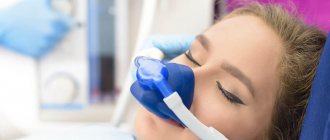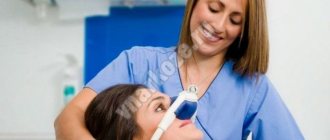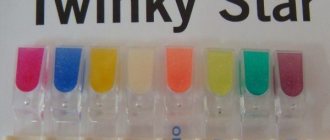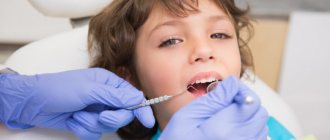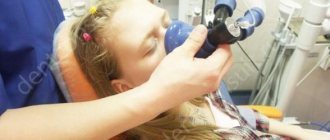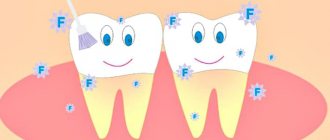Hello, dear readers, Lena Zhabinskaya is with you!
Today we will talk about problems with children's teeth. Read carefully to find out how to prevent serious problems and what to do if your baby’s teeth have already deteriorated.
When Leva was one and a half years old, I had to learn what dental treatment for children under anesthesia was like through my own bitter experience.
The article contains the whole truth from the first person about what it is, how it happens and is there an alternative?
When to treat?
Caries is a very insidious disease. It develops extremely rapidly, and in just six months it can turn into pulpitis.
Leva's first teeth appeared at eight months.
My mistake was that I didn’t take dental hygiene seriously, I thought, why brush two teeth, when they grow bigger, then we’ll brush them.
In general, I was lazy, to be honest, I didn’t know how everything would turn out.
As a result, by ten months there were already dark spots on the upper teeth, which I also didn’t attach any importance to - just think, maybe that’s the color of the enamel.
And by the age of one year, the four upper teeth at the base of the gums were already affected by caries.
I had never seen anything like this in anyone I knew, so we made an appointment with the dentist. The verdict was upsetting: caries needs to be treated. So small - only under anesthesia. This is not an easy decision to make, so we decided to think and observe. But in vain.
In this case, the rules “it will go away on its own” or “let’s wait and see” definitely don’t work. Treatment should be done as soon as possible, literally every week counts.
As a result, while we were waiting, the teeth began to look completely scary. Leva began to complain that it hurt him while brushing his teeth. At night I began to sleep very poorly and wake up crying. There was no waiting any longer.
Now I know that if a toddler is one year old, and caries has already appeared, there is no point in waiting, because by the age when it will be possible to come to an agreement with him and treat him as an adult, there will be nothing left to treat - the teeth will be destroyed, and all that remains is to remove them in order to stop the inflammatory process and the baby’s suffering from pain in the affected teeth.
And tooth extraction at the age of 3-5 at the time of formation and consolidation of speech skills is very undesirable.
So, do baby teeth need to be treated?
The child’s body is very, very vulnerable in the early periods of development in relation to any microbes, toxins, but if a baby tooth is damaged, it is dangerous for the child, because This is a serious source of infection. Such a stupid mistake or oversight can lead to chronic diseases of the throat, kidneys, liver, heart, and can also lead to intoxication of the child’s body. Do baby teeth in children need to be treated if loss can lead to eating disorders and stomach disease? How to care for a child’s teeth after one year of age If you have not consumed carbohydrates correctly, damaged teeth are often caused by this. All this is not only because of sweets, but even milk with sugar or water at night. Due to the fact that saliva is not secreted at night, then this self-cleaning effect does not occur. Both the smallest and the largest suffer from caries caused for this reason.
Who should be treated?
Dental treatment under anesthesia is indicated:
- small children under three years old with whom it is impossible to come to an agreement;
- older children, if they also cannot be seated in a chair.
If the child is over three years old and is fairly calm and obedient, you can try to have his teeth treated in several trips to the dentist.
In this case, local anesthesia (injections in the gum) or nitrous oxide (laughing gas) will be used.
If the baby is very active, restless and does not respond to persuasion, there is only one way out - to treat with the use of anesthesia.
In our case, Lyova could not sit still for even a couple of minutes; even a simple thirty-second examination in the dentist’s chair was a problem, so there was no talk of any persuasion.
Treatment of baby teeth without pain and tears - what pain relief methods are used today
A visit to the dentist most often turns into a real test for a young patient, and not only for him alone. Parents, like their frightened children, are worried and worried that the treatment will not cause pain to the child and will not become a serious stress for him. Therefore, most mothers and fathers have quite natural questions: is it painful to drill children’s teeth and how effective are the pain relief methods that are used today in pediatric dentistry? You will find the answers to them later in this article.
Is it painful to treat children's teeth?
Where to treat.
Even anesthesia using sevoran is a general anesthesia, that is, a very serious intervention in the body. Therefore, the choice of the place where the child will be treated must be approached with all possible responsibility.
This can be done in a public hospital, often even free of charge with a referral from a dentist from a children's clinic, or in a private clinic.
I studied the reviews online in detail, and this is what I found out.
Almost all dentists treat children from the age of three only and only with the use of local anesthesia.
To carry out manipulations with children under three years of age, especially with the use of anesthesia, special permits and expensive equipment are required, including for carrying out resuscitation measures.
Be sure to ask about the availability of such documents and equipment in the chosen dentistry.
Having studied everything in detail on the Internet, I identified two clinics in our city where dental treatment for children under anesthesia is routine.
One is private, the other is semi-public. We went for consultations to both of these clinics and settled on a private one for the following reasons:
- The smiling, very friendly doctor immediately found contact with the child and answered all my questions in detail and without haste. She assured that they would definitely try to cure and restore the teeth, and not remove them.
- You can choose a convenient time and day for the procedure.
- You can treat everything quickly in the shortest possible time.
- The most modern drugs are used both for anesthesia (only sevoran, and not complex anesthesia as in a public hospital), and for dental restoration (special “caps”) and fillings.
- A smaller number of various certificates and analyses, only the most necessary ones.
- Almost immediately after treatment, if everything is fine, you can go home.
In a semi-state clinic it was half the price, but:
- A tired, indifferent doctor who conducted the consultation made absolutely no attempt to establish contact with the child. She said that if during treatment the doctor decides that the teeth cannot be saved, they will be removed. So simple.
- Make an appointment two months in advance for certain working days of the week.
- Complex anesthesia was used: both intravenous and sevoran.
- A huge pile of tests, procedures, including from my mother - for HIV, syphilis, fluorography.
- Treatment was carried out twice a week, several people signed up for the same morning time, and there could be a queue on the day of treatment. Considering that the child is hungry, this is generally tough.
- After treatment, I had to stay in a three-bed hospital room under observation until the evening.
In general, keep in mind that different clinics have different rules. Therefore, choose the one that suits you in all respects.
At what age can a child’s teeth be treated?
While the baby is feeding on his mother's breast milk, his teeth are safe and sound. When you start feeding something new, be careful! Is it necessary to treat baby teeth in children after the kids begin to eat at the common table where adults eat, if there are pets in the house and they are exposed to a new, much greater danger. Dental problems begin due to deficiencies in minerals in the body, which makes them vulnerable. Poorly protected teeth under the influence of external influences expose you to new possibilities of disease. The dental tissues have not yet fully matured and are subject to the constant threat of caries. From five to fourteen years old is the most dangerous period in the life of a new person. During this period, children's teeth change rapidly. If parents pay close attention, take them to an orthodontist and dentist for examinations, and carefully monitor hygiene, your child will not have any problems.
Preparing for treatment.
Before treatment, it was necessary to undergo tests and obtain a certificate:
- Detailed general blood test.
- General urine analysis.
- Electrocardiogram or ultrasound of the heart.
- Certificate from a pediatrician about your health status.
Before treatment, you must not eat for eight hours and not drink for two hours.
This is because one of the side effects is nausea and vomiting. You need to put a disposable diaper on a child, because the muscles relax, and even a ten-year-old child can wet himself, let alone toddlers.
Try to plan everything so that the treatment time is in the morning - in this case it is easier to comply with the requirement of an empty stomach.
Make sure in advance that you are not alone on the day of treatment.
You will need an accompanying person. Ideally, the father or another male person, because after the procedure the child will most likely have to be carried in his arms, plus he may not behave appropriately.
Take care of transport in advance. Ideally, this is a personal car or taxi. Don’t even think that after treatment you will travel by public transport - your child’s condition will not allow it.
Treatment.
I still remember this terrible day with trembling.
It was Saturday.
My husband and I brought our one and a half year old toddler to the clinic.
Before the procedure, the anesthesiologist spoke with us in detail.
He looked at all the tests, spoke in detail about anesthesia, its consequences, and what to pay attention to in the coming days.
When I asked how often he had to work with such young patients, he replied that his main job was in a state children's hospital, and he even worked with newborns. I felt calmer.
After that, we took pictures of the teeth, and we learned that everything was much worse than it was at the previous examination five months ago. Instead of caries, we already had pulpitis, and there was a real threat of not saving our teeth, because they were already severely destroyed at the very base. Instead of forty minutes of anesthesia, we were faced with an hour, or even more.
In this clinic, everything was aimed at preventing the child from developing a fear of dentists. Therefore, during treatment under anesthesia, he should not have seen them at all. The idea was that when he falls asleep, he sees his mother, and wakes up after treatment with his mother too.
Somehow I persuaded my Levushka to sit in the dental chair; he didn’t even want to just sit. When they put a mask on him with incoming gas, he began to cry and struggle. My task was to hold the mask to his face and prevent him from escaping and inhaling air. He twitched, screamed and called for dad.
In Hollywood films, the patient falls asleep on the second breath wearing these masks. In real life it lasted an endless forty seconds.
To say it was a scary mission is an understatement.
Finally, my bunny went limp and passed out. Feeling like a terrible traitor, I left the office, and the doctors began treatment.
The anesthesiologist was in the office all the time and monitored Lyova’s condition.
Time passed slowly.
Finally, the doctor came out and we were relieved to hear that everything was fine, all the teeth were cured and restored with caps. I was invited into the office. The mask had already been removed, and Lyova should soon come to his senses. The teeth were truly unrecognizable.
But I was much more worried about him waking up after anesthesia.
Advantages of dental treatment under anesthesia
Dental treatment for children with retention means a high probability of psychological trauma, as well as the risk of damage to soft tissues by the rotating parts of the instrument. Children who are forced to resist cannot perceive the situation as safe.
Dental treatment for children during sleep has a number of undeniable advantages:
- all manipulations are absolutely painless;
- You can treat the maximum number of teeth in one session;
- surgical operations can be performed in the oral cavity;
- The quality of the dentist’s work improves; he is not in a hurry, but works faster.
Working with a calm or sleeping child is a guarantee that treatment will take place as quickly and effectively as possible.
After treatment. Consequences of anesthesia.
The instructions for Sevoran indicate the following side effects:
- - drowsiness and dizziness;
- - changes in blood pressure, tachycardia, bradycardia;
- - cough, breathing problems;
- - nausea, vomiting;
- - chills, fever, etc.
I’ll tell you clearly how this affected us. Ten minutes later, Lyova began to regain consciousness. I stroked his head and talked to him kindly. But it was as if he woke up not himself. I will never forget his panicked look and incessant scream. He started screaming just non-stop, losing his voice, choking, breaking out of his hands and not reacting to anything.
Dima carried him out in his arms and put him in a car seat in the car.
We drove thirty minutes to the house amid incessant screaming. Dima also carried Lyovushka home in his arms.
Only in my arms with his favorite bottle did he fall silent and fall asleep. I sat there, afraid to move.
A couple of hours later, Lyova woke up in a more or less adequate state and even played a little.
By evening the temperature rose to 39.8 degrees.
There was no sign of Leva, he lay flat and trembled. The temperature did not drop at all. And only somehow I managed to reduce it to 38 degrees.
This went on for two days.
Fever is one of the possible consequences of anesthesia, but usually not as severe.
Only on the third day did the condition stabilize.
Dental treatment for children 2-3 years old
Most often, dentists detect dental diseases such as caries, pulpitis and periodontitis in young children.
Caries is a disease of the hard tissues of the tooth. When caries develops in children at 2 years of age, dental treatment must be carried out. The fact is that caries of baby teeth often leads to the appearance of a diseased permanent tooth. In addition, untreated caries contributes to the development of chronic tonsillitis, otitis, pharyngitis, and diseases of the gastrointestinal tract.
To treat teeth in children 2 years of age and slightly older, dentists use gentle methods of therapy.
One of the most popular treatment methods is teeth silvering . Its principle of action is to apply a solution of silver nitrate to the diseased tooth. Moreover, silver is applied to the tooth several times with an interval of 6-7 days. This method is effective only at the initial stage of caries. Its disadvantage is that the silver solution creates a film on the teeth that turns black over time. You can only get rid of such a black film together with the tooth.
Superficial childhood caries in the spot stage can be successfully treated using the remineralization method . During such treatment, the diseased tooth is coated with preparations that contain sodium and calcium. These microelements penetrate the tooth tissue and strengthen them. This method of treatment requires quite a lot of time, which is selected individually for each small patient.
Modern methods of dental treatment for children aged 3 years and younger include ozone therapy . Ozone destroys pathogenic bacteria and their metabolic products, which makes it possible to stop the development of caries.
The method of photodynamic therapy is also widely used in pediatric dentistry . It involves applying medicinal materials to the diseased tooth, which are then irradiated with a laser.
If caries has reached the middle or deep stage, the dentist is forced to open the carious cavity, clean it and install a filling .
As a result of the development of caries, a child may develop pulpitis (inflammation of the tooth pulp) or periodontitis (inflammation of the tissues surrounding the tooth root). When pulpitis or periodontitis appears in children 2-3 years old, treatment requires more effort and is selected individually for each child.

